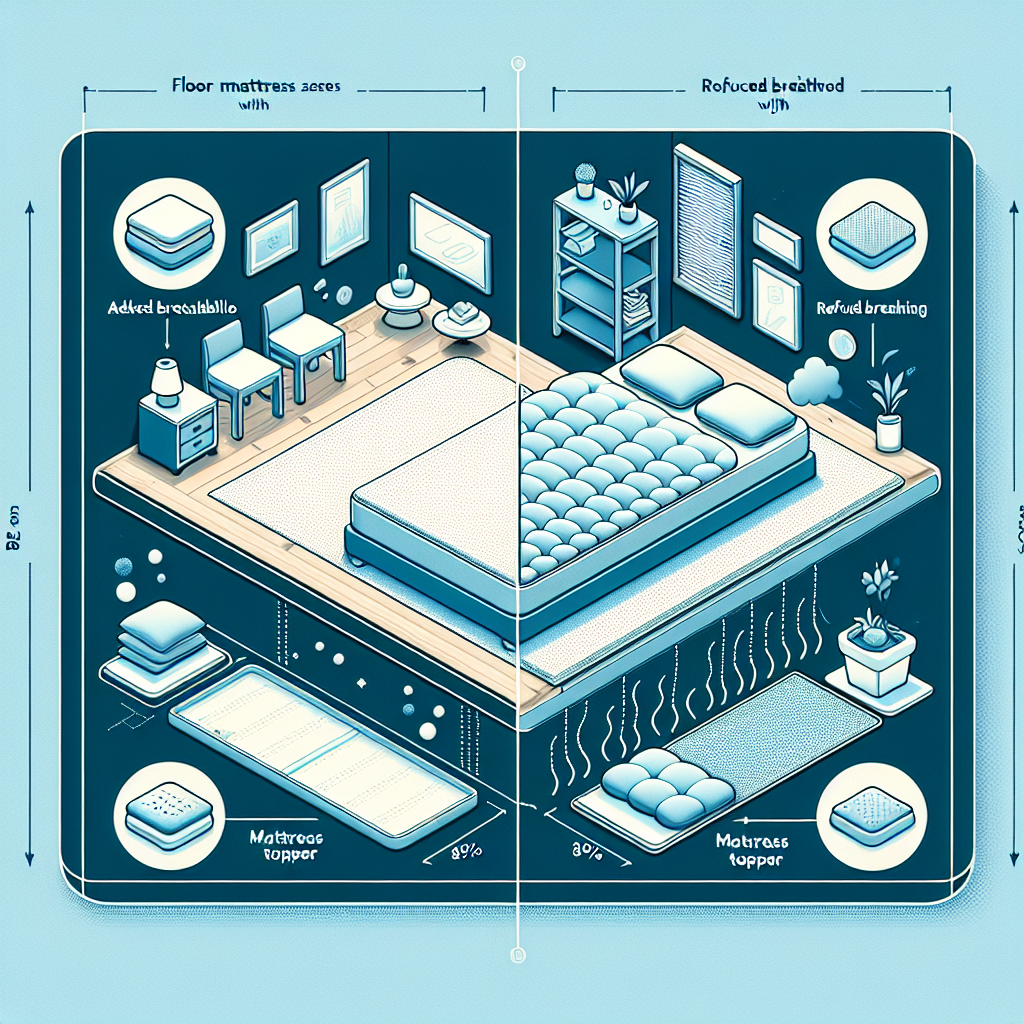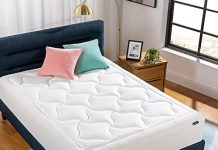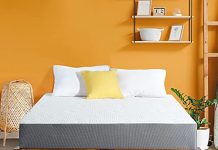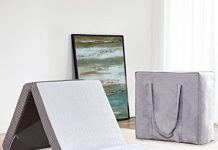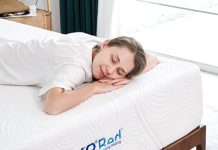Curious about whether or not a mattress topper is necessary when using a floor mattress? We’ve got you covered! In this article, we’ll explore the pros and cons of adding a mattress topper to your floor mattress setup. Whether you’re looking for that extra bit of comfort or are simply on the fence about making the investment, we’ll help you decide if a mattress topper is the missing piece to your floor sleeping experience. So, let’s dive in and discover if a cozy mattress topper is the right choice for you!
Review contents
Reasons to Use a Mattress Topper with a Floor Mattress
Increased Comfort
Using a mattress topper with a floor mattress can significantly increase the overall comfort of your sleeping surface. Floor mattresses, while often convenient and space-saving, can be quite firm and lacking in cushioning. By adding a mattress topper, you can create an extra layer of softness and plushness, making your sleeping experience much more comfortable. The additional padding can help alleviate pressure points and provide a cushioned surface for a more restful sleep.
Added Support
In addition to increased comfort, mattress toppers can also provide added support to a floor mattress. Some floor mattresses, especially those with thinner or less supportive materials, may not provide adequate support for your body. This can lead to discomfort and problems such as back or joint pain. By using a mattress topper with a supportive material, such as memory foam or latex, you can enhance the support of your floor mattress and promote proper spinal alignment.
Temperature Regulation
Another advantage of using a mattress topper with a floor mattress is the ability to regulate body temperature. Some mattress toppers are designed with cooling gel or breathable materials that help dissipate heat and keep you cool during sleep. On the other hand, if you live in a colder climate or prefer a warmer sleeping surface, there are mattress toppers available with insulating properties that can provide extra warmth. By selecting a mattress topper that suits your temperature preferences, you can create a more comfortable sleep environment regardless of the floor’s temperature.
Hygiene and Protection
A mattress topper can also contribute to better hygiene and protection of your floor mattress. This is especially important if you use your floor mattress regularly or if it serves as a guest bed. Mattress toppers act as a barrier between your body and the mattress, preventing sweat, oils, and dead skin cells from seeping into the mattress. By keeping the surface of your floor mattress clean, you can ensure a more hygienic sleep environment and extend the lifespan of your mattress.
Extended Lifespan
Using a mattress topper can also help prolong the lifespan of your floor mattress. By providing an extra layer of protection, a mattress topper can shield your mattress from everyday wear and tear, spills, and stains. This can prevent premature deterioration and help keep your floor mattress in optimal condition for a longer period of time. Additionally, a high-quality mattress topper can be easily replaced or upgraded when needed, saving you the cost of replacing the entire mattress.
Considerations for Using a Mattress Topper on a Floor Mattress
Thickness and Material
When choosing a mattress topper for a floor mattress, consider the thickness and material of the topper. The thickness of the topper will determine how much cushioning and support it provides. Thicker toppers are generally better for individuals who desire a more plush and contoured sleeping surface. The material of the topper should also be carefully considered. Memory foam and latex toppers are popular choices due to their ability to conform to the body and provide excellent support, while down and feather toppers offer a luxurious and soft feel. Polyester and microfiber toppers offer affordability and easy maintenance, while gel toppers provide cooling properties. Wool toppers are known for their natural temperature regulation and hypoallergenic properties.
Floor Type
The type of floor you have should also be taken into account when using a mattress topper on a floor mattress. If your floor is hard or uneven, opting for a thicker mattress topper can help provide additional cushioning and a more even sleeping surface. On the other hand, if your floor is already carpeted or padded, a thinner mattress topper may be sufficient. Consider the specific needs of your floor type to ensure optimal comfort and support.
Stability and Slippery Surfaces
When using a mattress topper on a floor mattress, it’s important to ensure stability and prevent the topper from slipping or sliding. Some mattress toppers come with non-slip or grip features that help keep them securely in place. Additionally, placing a non-slip pad or gripper underneath the mattress topper can provide added stability, especially if your floor is smooth or slippery. This will prevent any potential accidents or discomfort caused by a shifting topper during sleep.
Allergies and Asthma
For individuals with allergies or asthma, it’s essential to consider the potential allergens and irritants that a mattress topper may harbor. Choosing a mattress topper made from hypoallergenic materials can help reduce the risk of triggering allergy symptoms. Look for mattress toppers that are specifically labeled as hypoallergenic and resistant to common allergens such as dust mites, mold, and mildew. Regular cleaning and maintenance of the mattress topper can also help minimize allergen buildup.
Mold and Mildew Concerns
Using a mattress topper on a floor mattress can create an additional layer that may contribute to moisture retention if not properly cared for. This can lead to the growth of mold and mildew, which not only affects the lifespan of the topper but also poses health risks. To prevent mold and mildew formation, choose a mattress topper with moisture-resistant properties and ensure proper air circulation in the room. Regularly cleaning and maintaining the topper will also help prevent the accumulation of moisture and potential mold growth.
Types of Mattress Toppers
Memory Foam Toppers
Memory foam toppers are known for their exceptional comfort and ability to contour to the shape of the body. They provide excellent support, pressure relief, and motion isolation, making them a popular choice among those seeking a luxurious and plush sleeping surface. Memory foam toppers come in various thicknesses and densities to suit different preferences and needs.
Latex Toppers
Latex toppers are highly durable, hypoallergenic, and resistant to mold, mildew, and dust mites. They offer excellent support, responsiveness, and temperature regulation. Latex toppers are available in natural latex, which is derived from the sap of rubber trees, or synthetic latex, which is made from petroleum-based materials. Natural latex toppers are preferred by individuals looking for eco-friendly options.
Down and Feather Toppers
Down and feather toppers are known for their luxurious softness and provide a cloud-like sleeping experience. They offer natural insulation and breathability, making them suitable for various climates. Down and feather toppers are lightweight, easily moldable, and provide a cozy and warm sleep environment. However, they may not be ideal for individuals with allergies or sensitivities.
Polyester and Microfiber Toppers
Polyester and microfiber toppers are an affordable and low-maintenance option. They offer decent comfort and support while being easy to clean and maintain. Polyester toppers are hypoallergenic and resistant to dust mites, making them suitable for those with allergies. Microfiber toppers mimic the feel of down, providing a softer and more luxurious sleeping surface.
Gel Toppers
Gel toppers are designed to regulate body temperature by providing cooling properties. They are often infused with cooling gel or gel beads, which absorb and disperse excess heat, ensuring a comfortable sleep environment. Gel toppers are suitable for individuals who tend to sleep hot or live in warmer climates.
Wool Toppers
Wool toppers offer natural temperature regulation, moisture-wicking properties, and hypoallergenic benefits. They help keep you warm in winter and cool in summer, providing a comfortable sleep surface year-round. Wool toppers are also resistant to dust mites and other allergens, making them a great option for individuals with allergies or sensitivities.
Factors to Consider When Choosing a Mattress Topper
Comfort and Support
When choosing a mattress topper, prioritize comfort and support. Consider your sleeping preferences and any specific areas of your body that may require additional support or cushioning. If you prefer a softer sleeping surface, memory foam or down and feather toppers may be more suitable. For individuals needing extra support, latex or gel toppers may provide the necessary firmness.
Body Temperature
Your body temperature plays a significant role in your sleep quality. If you tend to sleep hot, selecting a mattress topper with cooling properties, such as gel or breathable materials, can help regulate your body temperature. Conversely, if you sleep cold or live in a colder climate, opting for a mattress topper with insulating materials, like wool or down, can provide additional warmth. Choosing a mattress topper that aligns with your body temperature preferences will contribute to better overall sleep comfort.
Allergies and Sensitivities
If you have allergies or sensitivities, it’s crucial to select a mattress topper that is hypoallergenic and resistant to common allergens. Look for toppers made from materials such as latex, polyester, or microfiber, which are less likely to harbor dust mites, mold, or mildew. Additionally, regularly cleaning and maintaining the topper will help minimize allergen buildup.
Durability and Longevity
Consider the durability and longevity of the mattress topper before making a purchase. Toppers made from high-quality materials, such as natural latex or memory foam, tend to be more durable and resilient over time. Look for toppers with good reviews and warranties to ensure longevity and value for your investment.
Maintenance and Cleaning
Different mattress toppers require varying levels of maintenance and cleaning. Some toppers can be easily spot cleaned or machine washed, while others may require professional cleaning or dry cleaning. Consider your lifestyle and willingness to invest time and effort into maintaining the topper regularly. Opt for a topper that aligns with your cleaning preferences for convenience and longevity.
How to Choose the Right Thickness
Personal Preference
The right thickness of the mattress topper largely depends on personal preference. Some individuals prefer a thinner topper that provides a slight layer of cushioning without drastically changing the feel of the mattress, while others prefer a thicker topper for maximum comfort and support. Consider your desired level of softness or firmness when choosing the thickness of your topper.
Existing Mattress Firmness
The firmness of your existing floor mattress should also be taken into account when selecting the thickness of the topper. If your mattress is already firm or lacks cushioning, a thicker topper can help create a more plush and comfortable sleeping surface. Conversely, if your mattress is already soft or has a significant amount of cushioning, a thinner topper may be sufficient to enhance the support and comfort.
Body Weight
Body weight is an important factor to consider when choosing the thickness of a mattress topper. Heavier individuals typically require thicker toppers to provide adequate support and prevent sinking too deeply into the mattress. Lighter individuals may find thinner toppers sufficient for comfort and support. Select a thickness that best accommodates your body weight to ensure optimal rest and spinal alignment.
Sleeping Position
Different sleeping positions may require different thicknesses of mattress toppers. Side sleepers often benefit from thicker toppers that provide extra cushioning and contouring for the hips and shoulders. Back sleepers may prefer a medium thickness topper that offers a balance of support and comfort. Stomach sleepers, however, typically need a thinner topper to maintain proper spinal alignment. Consider your preferred sleeping position to determine the appropriate thickness of the topper.
Effect on Sleeping Temperature
Cooling Toppers
If you tend to sleep hot or live in a warmer climate, cooling mattress toppers can help regulate your body temperature and promote a more comfortable sleep environment. Look for toppers with cooling gel infusions or breathable materials that allow for better air circulation. These toppers can help dissipate excess heat and prevent overheating during sleep.
Heating Toppers
On the other hand, if you sleep cold or reside in a colder climate, a heating mattress topper can provide much-needed warmth and coziness. Some toppers are designed with heating elements or insulating materials to keep you comfortably warm during the colder months. Consider your climate and personal preference for sleeping temperature when selecting a mattress topper with heating capabilities.
Breathable Materials
Mattress toppers made from breathable materials, such as latex or wool, allow for better air circulation, which helps regulate body temperature. These materials wick away moisture and prevent excess heat retention, creating a more comfortable sleep environment. Choose a topper with breathable properties if you prioritize temperature regulation during sleep.
Insulating Materials
If you prefer a warmer sleeping surface, selecting a mattress topper with insulating materials can help retain heat and provide extra warmth. Wool toppers are known for their natural insulating properties and can help keep you cozy during colder nights. Insulating mattress toppers are especially beneficial for individuals who tend to feel cold while sleeping or live in chilly climates.
Addressing Allergies and Asthma Concerns
Hypoallergenic Materials
For individuals with allergies or asthma, using a mattress topper made from hypoallergenic materials is crucial. Look for toppers that are explicitly labeled as hypoallergenic and free from common allergens such as dust mites, mold, and mildew. Hypoallergenic materials, such as latex, polyester, or microfiber, are less likely to cause allergic reactions and can provide a healthier sleep environment.
Anti-microbial Properties
To further address allergies and asthma concerns, choose a mattress topper with anti-microbial properties. Some toppers are treated with antimicrobial agents that help prevent the growth of bacteria, mold, and mildew. These properties can contribute to better overall hygiene and air quality, reducing the risk of allergen exposure and respiratory problems.
Dust Mite Resistance
Dust mites are common allergens that can cause significant discomfort and allergic reactions. When selecting a mattress topper, opt for one that is resistant to dust mites. Toppers made from materials such as latex or polyester are naturally resistant to dust mites, making them suitable for individuals with dust mite allergies. Regular cleaning and maintenance of the topper will also help minimize dust mite presence.
Easy Cleaning
Regular cleaning and maintenance are essential for individuals with allergies or asthma. Choose a mattress topper that is easy to clean and maintain to reduce allergen buildup. Look for toppers that can be spot cleaned, machine washed, or easily vacuumed. Avoid toppers that require dry cleaning or professional maintenance unless you are willing to dedicate the necessary time and effort.
Preventing Mold and Mildew Formation
Moisture Resistance
To prevent mold and mildew formation, opt for a mattress topper with moisture-resistant properties. Moisture can accumulate on the surface of a floor mattress, leading to the growth of mold and mildew. Toppers made from materials such as latex, polyester, or wool are naturally moisture-resistant and help prevent the absorption of liquids. This reduces the risk of mold and mildew formation and keeps your sleep surface clean and hygienic.
Air Circulation
Proper air circulation is essential in preventing mold and mildew formation. Look for mattress toppers with breathable materials that allow air to flow freely. Latex and wool toppers are known for their excellent breathability, allowing moisture to evaporate and preventing the buildup of humidity. Proper air circulation helps keep the topper dry and reduces the risk of mold and mildew.
Anti-microbial Treatments
Some mattress toppers come with anti-microbial treatments that help inhibit the growth of bacteria, mold, and mildew. These treatments can provide an additional layer of protection against mold and mildew formation, ensuring a hygienic sleep environment. Consider choosing a mattress topper with anti-microbial properties for added peace of mind.
Regular Cleaning and Maintenance
Regular cleaning and maintenance of the mattress topper are essential in preventing mold and mildew. Properly clean and dry the topper according to the manufacturer’s instructions to remove any moisture or allergen buildup. Regularly vacuuming the topper and exposing it to sunlight can help eliminate potential mold or mildew spores.
Maintenance and Cleaning Tips
Regular Vacuuming
To keep your mattress topper clean and fresh, regularly vacuum the surface to remove dust, dirt, and allergens. Use a handheld vacuum or a vacuum cleaner with a soft brush attachment. Pay close attention to the crevices and corners of the topper to ensure thorough cleaning. Vacuuming at least once a month will help maintain the hygiene of your mattress topper.
Spot Cleaning
In the event of spills or stains, spot cleaning is often sufficient to remove the blemish. Use a mild detergent or upholstery cleaner and follow the product instructions carefully. Gently dab the affected area with a clean cloth or sponge, being careful not to scrub or rub vigorously. Allow the topper to air dry completely before using it again.
Deep Cleaning
Periodically, it is recommended to deep clean your mattress topper to maintain its freshness and remove any ingrained dirt or odors. If the topper is machine washable, follow the manufacturer’s instructions for a gentle wash cycle. If not, consider taking the mattress topper to a professional cleaner or dry cleaner. Deep cleaning is typically recommended once or twice a year, or as needed.
Sunlight Exposure
Exposing your mattress topper to sunlight can help eliminate any potential moisture or odors. Sunlight has natural anti-microbial properties and can also aid in the removal of dust mites. On a dry and sunny day, place the mattress topper outside in a well-ventilated area for a few hours. Be sure to check the manufacturer’s instructions to ensure sunlight exposure is safe for the specific material of your topper.
Alternative Options to Mattress Toppers
Mattress Pads
An alternative to mattress toppers is mattress pads. Mattress pads are generally thinner and designed to provide a protective layer against spills, stains, and minor wear. They are typically made from quilted or padded materials and offer minimal additional cushioning. Mattress pads are suitable for individuals who prefer a minimal change to the feel of their mattress while still enjoying some protection and hygiene benefits.
Futon Covers
If you have a floor mattress that doubles as a futon, using a futon cover can serve as both a protective and decorative option. Futon covers are available in a variety of materials, patterns, and colors, allowing you to personalize your sleeping surface. They provide a barrier against stains, spills, and wear and tear, extending the lifespan of your futon mattress. Futon covers are easily removable and washable, making them convenient for maintenance.
Mattress Protectors
Similar to mattress pads, mattress protectors offer a thin and waterproof layer of protection for your floor mattress. They are designed to safeguard against spills, stains, and allergens, effectively enhancing the longevity and hygiene of your mattress. Some mattress protectors also provide additional features, such as dust mite resistance or cooling properties. Mattress protectors are an excellent option for individuals who prioritize mattress preservation and easy cleaning.
In conclusion, using a mattress topper with a floor mattress can greatly enhance your sleeping experience. The increased comfort, added support, temperature regulation, hygiene and protection, and extended lifespan benefits make mattress toppers a valuable addition. When choosing a mattress topper, consider factors such as thickness and material, floor type, stability, allergies, and potential mold concerns. Explore the various types of toppers available, including memory foam, latex, down and feather, polyester and microfiber, gel, and wool. Evaluate factors like comfort and support, body temperature, allergies, durability, and maintenance when selecting the right topper. Thickness should be chosen based on personal preference, mattress firmness, body weight, and sleeping position. Different mattress toppers have varying effects on sleeping temperature, with cooling and heating options available. Consider allergies and asthma concerns, and look for hypoallergenic materials, anti-microbial properties, dust mite resistance, and easy cleaning. Prevent mold and mildew formation by choosing moisture-resistant toppers, promoting air circulation, utilizing anti-microbial treatments, and maintaining regular cleaning routines. Follow maintenance and cleaning tips such as regular vacuuming, spot cleaning, deep cleaning, and sunlight exposure. If mattress toppers are not suitable, explore alternatives like mattress pads, futon covers, and mattress protectors. With these considerations in mind, you can find the perfect mattress topper to enhance your floor mattress and improve your sleep quality.


